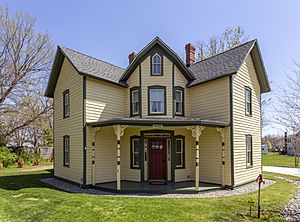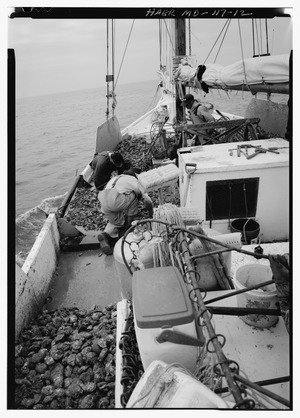Tilghman Watermen's Museum facts for kids
| Lee House | |

Lee House, Tilghman Watermen's Museum
|
|
| Lua error in Module:Location_map at line 420: attempt to index field 'wikibase' (a nil value). | |
| Former name | Tilghman Island Victorian House |
|---|---|
| Established | June 2008 |
| Location | Tilghman Island, Maryland, US |
| Type | Maritime museum |
| Founder | Hall and Mary Kellogg |
The Tilghman Watermen's Museum is a special place that tells the story of the people of Tilghman Island, Maryland. It focuses on the unique way of life of the "watermen" who have lived and worked on the island for many years. The museum first opened in 2008. It is located on Tilghman Island in the United States.
The museum started in an old barbershop. In June 2015, it moved to a historic building called the Lee House. This house is a great example of a special type of building found only on Tilghman Island. It is known for its "W" facade design.
Life of Tilghman Island Watermen
When people first settled the Chesapeake Bay area in the 1600s, it was full of fish and seafood. The waters around Tilghman Island were especially rich with oysters. "Watermen" are people who earn their living from the water. They do many jobs like crabbing, oystering, and fishing. They also helped pack and can seafood.
Shipbuilding was also important on the island. Special boats were created for the local waters. Log canoes with sails were adapted from boats used by Native American tribes. Skipjacks are two-masted sailboats used for catching oysters. A Maryland law says that motors cannot be used for oystering. This is why skipjacks are still the main boat for this work.
Most watermen live in small towns by the water, like Tilghman Island. They often own their own boats and equipment. They work long hours and travel far to find fish or oysters. Crabbing usually happens in the summer. Oystering is done in the winter. Fishing takes place during the spring, fall, and winter.
How the Museum Started
The idea for a museum on Tilghman Island began in 2007. A group of island residents wanted to help save the Kathryn, a famous Chesapeake Bay skipjack boat. This project made them realize how important it was to save the history of their local area.
The Tilghman Island Museum opened its doors in June 2008. It was started by Hall and Mary Kellogg, who lived on the island. At first, the museum focused on collecting stories from watermen. These stories were recorded as "oral histories." A video called Growing up on Tilghman was made in 2010 using these stories. It has even been shown on Maryland Public Television.
Over time, the museum added more things to see. They now have items related to watermen and the island. You can also see small models of boats and local artwork. Many artists and photographers enjoy visiting the area.
The museum's first home was an old barbershop. It was located at 5778 Tilghman Island Road. This barbershop used to be where islanders Duckey Scharch and Johnny Moore worked. It still had the original mirrors and other old fittings. However, since it was a rented space, it was hard to make it bigger.
In 2010, the Kelloggs bought the Lee House. This was a historic building on the island. They also received a grant to help restore it.
The Historic Lee House
The Lee House is a very old building. It was added to the Maryland Historical Trust list of historic properties in 1977. It is located about half a mile south of the Knapps Narrows Bridge, just off Route 33.
The Lee House was built around 1890. It is the best example of a special type of house called a "W" facade house. This style of building is unique to Tilghman Island. The Maryland government says that about thirteen of these houses were built between 1890 and 1900. The Tilghman Watermen's Museum says that twelve were on Tilghman Island, and two others were in Sherwood, Maryland. Today, only five of these special houses are still standing.
The Lee House is a two-and-a-half-story wooden house shaped like an "L." It has two equal parts. In the corner of the "L" shape, there is an entrance with a main door and windows on each side. People who lived in the area said that this unique design helped air flow through the house. This kept it cool, no matter which way the wind blew.
The Lee family were the first owners of the house. They lived there until the 1930s. Later, the house was passed down to Leona Garvin Harrison. She lived nearby at "The Elms," which was a popular resort on the island. Ms. Harrison used the Lee House as a place for extra guests and fishing groups to stay. Up to twelve people could sleep there at a time. They would eat their meals at The Elms. The Lee House was empty after 1971. It was passed down through the family until the Kelloggs bought it.
The Lee House is important because it shows something special about Tilghman Island. Just like the watermen and their way of life, the house is a unique part of the island's history.


